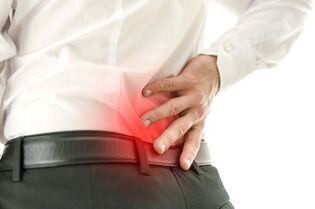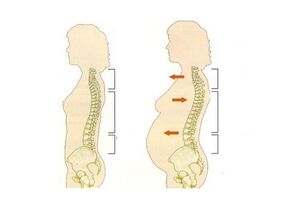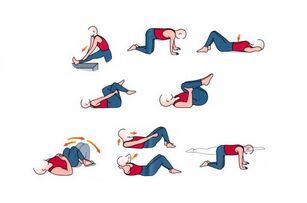Unfortunately, there are no completely healthy people in the world. We all regularly worry about something in the state of our own organization. This is probably why we wish each other health, well-being, complemented by good mood.
Low back pain is one of the most common complaints. And if in our childhood it seemed to affect only the elderly, then after their maturity came the recognition of the wrong opinion. We are not insured against back pain by age, social status or type of activity. And this is mainly due to the different causes of lumbar spine pain as well as its different manifestations.
Diseases that cause low back pain
Often, low back pain is caused by a specific disease and is a consequence - a symptom whose nature allows for targeted diagnosis, correct diagnosis, and ways, methods, and tactics in general to treat the disease.

Primary or secondary pain in the lumbar region.
Theprimer is directly related to spinal diseases:
- articular cartilage osteochondrosis or dystrophic disorders (one-third of all patient visits);
- "bulge" of the intervertebral disc outside the boundaries of the spine (protrusion), displacement of the disc core in which the annular fibrosis breaks (intervertebral hernia);
- Displacement of one or more vertebrae: forward, backward;
- accelerated the aging and destruction of cartilage in the intervertebral joints (spondyloarthrosis);
- growth of bone tissue along the edge of the spine in the form of thorns (spondylosis).
Secondary pain is caused by diseases of other organs:
- vertebral fracture caused by trauma or osteoporosis (increased fragility of the bones);
- tumor appearance in one part of the spinal canal (lumen);
- muscle tension;
- congenital insufficient width of the spinal canal;
- any curvature and combination of spine, including deformity, leading to the appearance of a "hump" in the chest spine;
- various types of arthritis / joint diseases (psoriasis, rheumatism and others);
- vertebral tuberculosis and other inflammatory processes affecting the intervertebral discs;
- kidney / urinary stones, pyelonephritis (kidney damage);
- ovarian cysts, including cancer;
- spinal pain is also possible as a complication of pregnancy in women.
What can the nature of low back pain indicate?
Of course, it is impossible to diagnose the extent, level, type of back pain on your own. But nonetheless, if your back hurts, some specific symptoms indicate to us this or that disease.
Severe pain
If the lumbar spine pain is severe, it is likely that the patient has osteochondrosis or sciatica. Moreover, in the first case, it manifests itself in the process of walking, when a person sits for a long time, lifts weights, and even when he coughs or sneezes. In some cases, there may be complaints that your back hurts and that pain radiates to your legs.
When talking about radiculitis, the patient often describes the pain as acute or dull, sore - unilateral, and "reacts" in the thigh, lower leg, buttocks. It can increase with walking, changes in the position of the human body, coughing.
What can acute lumbar pain indicate?
In case the pain is severe, you should talk about the following:
- muscle tension;
- long-term work in an awkward position for the trunk;
- post-sleep back pain due to uncomfortable body position and significant duration of stay;
- pain in the process of lifting or carrying a weight in the event of a fall, impact, or sudden movement;
- hypothermia or exposure to prolonged drafts;
- is also likely to cause lumbago (called lumbago) in patients with severe physical work. In this case, the lower back pain may go away in a few days, but it can also linger and accompany the person for two or more weeks; Dislocations of the intervertebral discs
- in the lumbar region - often with spinal fractures, osteochondrosis, interactions with heavy objects (especially lifting them), appear as a result of heavy physical operations or as a result of surgery.

The sore nature of pain: what are you talking about?
Painful pain (the patient's description can be described as "lower back pain" or "lower back pain") - very often manifests itself in an inflammatory process in the lumbar muscles.
This condition results from hypothermia or sudden muscle tension / overload. In this case, the patient defines pain as limiting the lumbar spine and is associated with sharp pain while moving.
Chronic, persistent low back pain
If the lower back hurts and even the patient himself can describe it as chronic, the diagnosis is likely to be as follows:
- spondylosis deformans - an increase in the amount of bone tissue in the spine due to the appearance of spine-like growths along the edges of the vertebrae (manifested by severe back pain, especially in the lumbar region, which may combine numbness and / or weakness in the legs); disease of the vertebral joints
- - most often of a chronic systemic nature;
- many oncological diseases;
- metabolic disorders.
Pain without constant localization, moving
One of the most difficult cases of identifying the underlying diseases is the sometimes moving pain. At the same time, one can be sure that his lower back is hurt, when in fact the body is “tricked” and the disease has crept into other organs as well.
These pains are often caused by diseases of the pelvic organs. Inflammatory processes in the kidneys, diseases of the pancreas, and colon can contribute to the appearance of pain in the lumbar spine and can also occur due to painful changes in bone tissue and other types of tumors.
Sometimes the painful condition of the lower back is confused with the pain in the area of the shoulder blades. However, these are still different types of pain and are mostly associated with different diseases. Thus, shoulder blade pain indicates, for example, gastric ulcer, myocardial infarction, intercostal neuralgia, and even a person’s psychological problems.

If you have difficulty identifying the area where the pain occurs and are regular or intense at the same time, see a doctor right away!
Injuries leading to low back pain
Oddly enough, but very often in the lumbar region, the cause of pain is an injury suffered by a person - such as a bruise or sprain on the back muscles. Timely doctor visits guarantee correct diagnosis and effectiveness of treatment.
In advanced cases, there is a high probability of complication, not excluding severe curvature of the spine.
Specifics of women's back pain
“What are the specific causes of low back pain in women? ” you ask. And we answer that there are not so few. And people usually owe it to the Creator to the fact that these reasons simply cannot exist.
The "provocateurs" of women's lumbar pain are:
- menstruation / period;
- pregnancy;
- vertex.
In each case, the pain may be different. Depending on the immediate cause, the characteristics of the female body, the degree of lower back stress during pregnancy, the woman's age, employment, and the type of professional activity, the pain manifests itself in different ways.
But what about men?
Unfortunately, painful lower back syndrome is quite common in men.
And there's enough reason for it without the female component:
- stretching (accompanied by muscle, sharp pain);
- spinal fracture (after a man has recovered or when a man has been hit in the lower back), men very often get such injuries in car accidents;
- protrusion / bulging of the intervertebral disc or displacement of multiple intervertebral discs as pressure begins to exert on the nerve roots, this pathology usually arises and is diagnosed through excessive physical activity;
- an increase in genital cancer metastases in men, most commonly after the age of 50; at the same time, the pain develops with a change in the degree of damage to the bone tissue and is so severe that it can only be stopped by taking special drugs, painkillers;
- spondyloarthrosis (when the nerve root or more roots are damaged in the area of the intervertebral canal);
- in the case of radiating painful manifestations, they indicate the presence and development of diseases of the prostate gland, problems with the liver or kidneys.
Risk factors: what can cause low back pain?
Unfortunately, we cannot insure ourselves against this or that disease. But within our competence, we study the risk factors — the most common causes of the disease — and take action to eliminate them (if possible), or at least partially neutralize their effects on the body.
The most common, pronounced risk factors for lower back pain are:
- performing intense exercise with high physical exertion (gym), especially on the spine and lumbar spine;
- sudden awkward movement;
- has been in the same position for a significant period of time (for example, people whose activities involve driving a car, working at a computer, or even a job in which a person is forced to stand for a long time - consultants in shops, pharmacists));
- In the morning, the lower back can also hurt, which “says” that the mattress or pillow is not right for you, but does not rule out the inflammatory process, which is thus symptomatic;
- work based on high physical or mental stress, stress can also manifest itself in low back pain;
- As mentioned earlier, both pregnancy and childbirth increase the likelihood of lower back pain;
- Heavy weight and low back pain are also closely related, as the pressure exerted on a person’s internal organs and spine depends on their total body weight.

When do you need medical attention?
As we hate illness, we hate the help of doctors. There are several methods to independently identify the causes and treatment of diseases. Of course, there are reasons for this belief.
But in case of back pain, you still want to differentiate somehow: here you can go to bed, treat yourself alone, but here - without the help of a doctor, sometimes urgently! - It's just not enough.
We can clearly state that if the pain is one-off or the cause of the pain is one of the causes of the female line, then in principle you cannot panic, but wait, observe the body, give it a chance to rest, not overload.
If the pain is not delayed and does not recur, you have correctly identified the cause and can do so without medical intervention.
For low back pain:
- is repeated systematically;
- transfer and continuation; the
- are amplified;
- the pain persists for more than three days; the
- is repeated in the morning;
- is injured and associates it with pain in the lower back;
- feel pain in the lower back and legs (legs and lower legs) at the same time;
- or - lower back pain is combined, and with it, the buttocks and legs (thighs, lower legs, feet) and even the groin area are numb - this is a serious reason for an urgent medical visit!

In none of the above cases, you need to find out for yourself the causes of the pain, why the lower back hurts, and see a doctor immediately. Without medical help, the situation can get worse and the treatment will require much more time and effort.
Remember that back pain, lower back pain, is not a case where you can joke or hope “randomly” (e. g. , deformities or displacements in the intervertebral discs have never been corrected by yourself).
Failure to diagnose pain and proper treatment in a person can lead to serious, complicated diseases, lumbar surgery, and even paralysis and disability of the lower body.

























